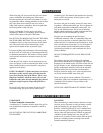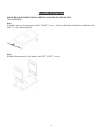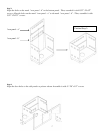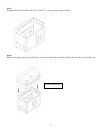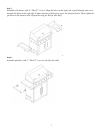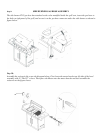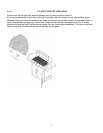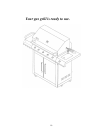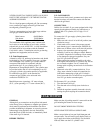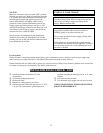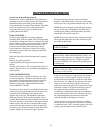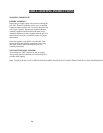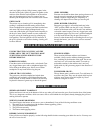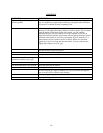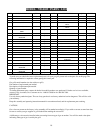Special offers from our partners!

Find Replacement BBQ Parts for 20,308 Models. Repair your BBQ today.

11
GAS HOOK-UP
NEVER CONNECT AN UNREGULATED GAS SUPPLY
LINE TO THE APPLIANCE. USE THE REGULATOR
ASSEMBLY SUPPLIED.
This is a liquid propane configured grill. Do not attempt
to use a natural gas supply unless the grill has been
reconfigured got natural gas use.
Total gas consumption (per hour) of the large stainless
steel gas grill with all burners on “HI”:
Main burners 60,000 Btu/hr.
Side burner 12,000 Btu/hr.
Total 72,000 Btu/hr.
The installation of this appliance must conform with
local codes or, in the absence of local codes, with the
national fuel gas code, ANSI Z223. 1a-1988. Installation
in Canada must be in accordance with the Standard
Can1-b149.1 and/or .2 (installation code for gas burning
appliances and equipment) and local codes.
L.P. Tank Requirements
A dented or rusty L.P. tank may be hazardous and should
be checked by your L.P. supplier. Never use a cylinder
with a damaged valve. The L.P. gas cylinder must be
constructed and marked in accordance with the
specifications for L.P. gas cylinders of the U.S.
Department of Transportation (DOT). The cylinder must
be provided with a shut off valve terminating in an L.P.
gas supply cylinder valve outlet specified, as applicable,
for connection type QCC1 in the standard for
compressed gas cylinder valve outlet and inlet
connection ANSI/CGA-V-1.
Manifold pressure: (operating): 10” water column
(W.C.), (non-operating): 11.2” water column (W.C.).
L.P. GAS HOOK-UP:
Ensure that the black plastic grommets are in place and
that the hose does not come into contact with the heat
shield or the grill head.
CONNECTION:
Orifices for use with L.P. gas come equipped with a high
capacity hose/regulator assembly for connection to a
standard 20lb. L.P. cylinder (18-1/4” high, 12-1/4”
diameter).
To connect the L.P. gas supply cylinder, please follow
the steps below:
1. Make sure tank valve is in its full off position (turn
clockwise to stop)
2. Check tank valve to assure it has proper external
male threads (type 1 connection per ANSIZ21.81)
3. Make sure all burner valves are in their off position.
4. Inspect valve connections port and regulator
assembly. Look for any damage or debris. Remove
any debris. Inspect hose for damage. Never attempt
to use damaged or plugged equipment. See your
local L.P. gas dealer for repair.
5. When connecting regulator assembly to the valve,
hand tighten nut clockwise to a positive stop. Do not
use a wrench to tighten. Use of a wrench may
damage quick coupling nut and result in a hazardous
condition.
6. Open tank valve fully (counterclockwise). Use a
soapy water solution to check all connections for
leaks before attempting to light grill. If a leak is
found, turn tank valve off and do not use grill until a
local L.P. gas dealer can make repairs.
To disconnect L.P. gas cylinder:
1. Turn the burner valve off.
2. Turn the tank valve off fully (turn clockwise to
stop).
3. Detach the regulator assembly from tank valve by
turning the quick coupling nut counterclockwise.
LEAK TESTING
GENERAL
Although all gas connections on the grill are leak tested
at the factory prior to shipment, a complete gas tightness
check must be performed at the installation site due to
possible mishandling in shipment, or excessive pressure
unknowingly being applied to the unit. Periodically
check the whole system for leaks, or immediately check
if the smell of gas is detected.
BEFORE TESTING
Make sure that all packing material is removed from the
grill including the burner tie-down straps.
DO NOT SMOKE WHILE LEAK TESTING.
NEVER LEAK TEST WITH AN OPEN FLAME.
Make a soap solution of one part liquid detergent and
one part water. You will need a spray bottle, brush, or
rag to apply the solution to the fittings. For the initial
leak test, make sure the L.P. cylinder is full.



